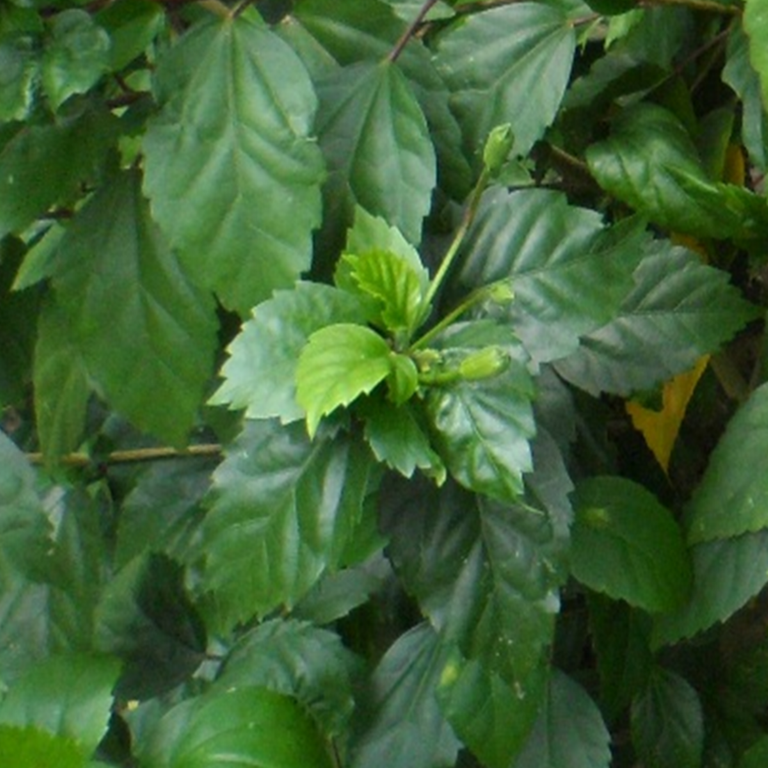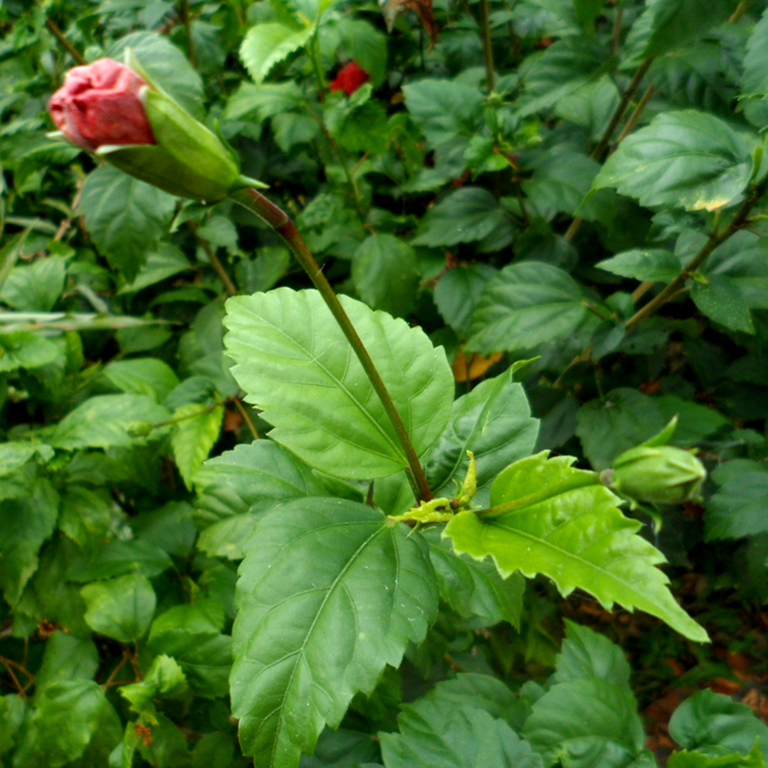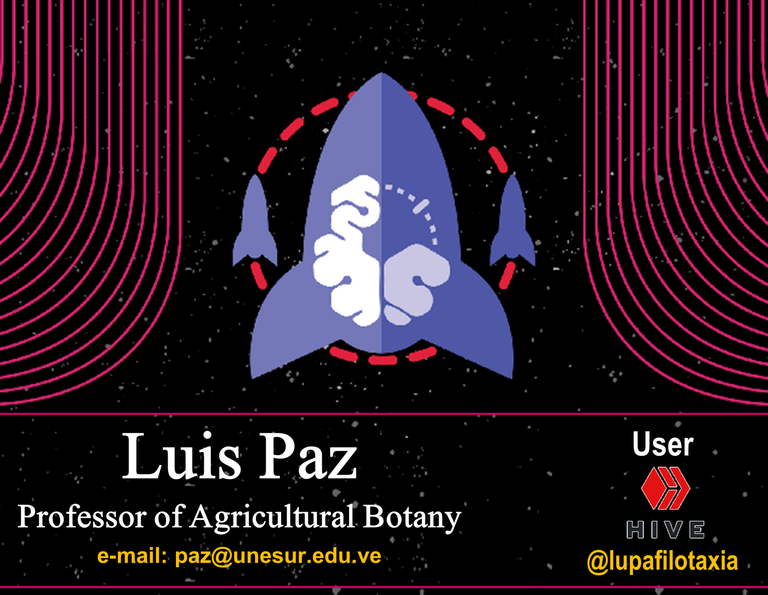Morphophenological behavior of related specimens of Hibiscus rosa-sinensis

The publication, aims to present experimental information, mainly for users who love STEM content, in the manuscript will find content on biotechnology as a tool for genetic improvement, and some results obtained in the field, on the morpho-phenological behavior of related specimens of Hibiscus rosa-sinensis.
Introduction
It is intuitively known that the multiple cell divisions at the end of the phenological cycle in plant species occur with the aim of ensuring the descent of a given taxon, to generate reproductive segments (sexual reproduction), however, it is important to mention that these cell divisions also produce vegetative or meristematic buds on the parent plant, specifically in lateral and apical regions, which act in an equivalent way ensuring offspring in a process called asexual reproduction [1].
Now, it is understandable that plant taxa that reproduce asexually are represented by populations of morphologically uniform specimens, because they originate from the same paternal material, which is why this type of population and its specimens are called CLON.
Consequently, and taking into account the vegetative variability observed in some taxa that reproduce asexually, the objective of the present post is to socialize the morpho-phenological behavior of vegetative meristematic segments of Hibiscus rosa-sinensis, from related material F1, F2, F3, F4.
Phytobreeding
From the biological point of view, it is a mistake to assume that the asexual reproduction experienced by plants generates morphologically uniform specimens, because the same inbred line can trigger multiple morpho-phenological differences, either vegetative or reproductive, Hence, both in agriculture, horticulture, and floriculture techniques are usually used to generate asexual materials that are morphologically similar or of little variability, which can be accepted in specific markets.

Fig. 2 Apical meristematic segment of Hibiscus rosa-sinensis. Author: @lupafilotaxia.
Dialelic crossings
Within the techniques of breeding, the dialelic crossing is the main procedure used in the mating processes, this because, it schematizes simple crosses between a group of n progenitors, whose result serves to achieve the use of a certain vegetal material with greater development and eco-physiological adaptability. In the same way, it is to manifest that the systems of dialelic crossings, have as main objective to identify the potential progenitors that allow stable morpho-phenological crossings [1] .
Morphology of Hibiscus rosa-sinensi
Hibiscus rosa-sinensi or Cayenne as it is commonly known, belongs to the Malvaceae family, these are specimens of bush biotype, pivoting root, woody stems, leaf blades of intense green color, with lobes, serrated edge, slightly long petioles, and alternate phyllotaxy, axillary, bisexual flowers of bell-shaped corolla, polychromatic color, petals with dark spot in the inner segment, cup-shaped calyx, densely hairy fruit with a capsule to oval morphology, black seeds and reniform aspect [3].

Fig. 3 Reproductive segment of Hibiscus rosa-sinensis. Author: @lupafilotaxia.
Morpho-phenological field trial
Area of study
In order to socialize some techniques used in plant breeding, I will share with all of you an experimental procedure on the morpho-phenological vegetative uniformity of four (04) specimens of Hibiscus rosa-sinensi (ESPm1: yellow flowers, ESPm2: red flowers, ESPm3, white flowers, ESPm4: pink flowers), the trial was developed at the Botanical Garden of UNESUR, a university institution located in Santa Barbara of Zulia - Venezuela.
Methodological approach
In order to record the morpho-phenological vegetative uniformity of specimens of Hibiscus rosa-sinensi, we proceeded to collect meristematic segments of related material F1, F2, F3, F4 planted in the ornamental area of the Botanical Garden of UNESUR. After the collection of the meristematic segments, the rooting, growth and development phase began, for which each vegetative material was placed in black polyethylene bags at a rate of 500 grams of organic substrate. Finally, and with the purpose of determining the vegetative morpho-phenological uniformity of the specimens of H. rosa-sinensi subject to evaluation, there were registered the following vegetative parameters; height of seedlings, diameter of the main axis, number of primary and secondary branches, emission and foliar morphology.
Morphophenological data
For the purpose of this study, vegetative morpho-phenological data were recorded from day 60 after the emission of the first vegetative bud, at intervals of every 30 days until day 180.
Materials and reagents used
- Meristematic segments of Hibiscus rosa-sinensi
- Organic Substrate
- Black polyethylene bags
- Measuring tape
- Bernier
Morpho-phenological results
In relation to the response of the considered vegetative parameters, the height of the seedlings and the diameter of the main axis, did not show significant effects, which supposes certain homogeneity between the four specimens evaluated in field, nevertheless, the statistical analysis used to determine the number of primary and secondary branches, emission and foliar morphology, if it presented significant differences, being the specimen ESPm2 (red flowers) the one that presented the highest values.

Fig. 4 Vegetative structures of specimen ESPm2 of Hibiscus rosa-sinensis test subject. Author: @lupafilotaxia.
CONTRIBUTIONS OF THIS PUBLICATION
- The information socialized in this post, needed to share with users of the HIVE platform technical content related to plant breeding, mainly on the morpho-phenological behavior of related specimens of Hibiscus rosa-sinensi. The results obtained in the trial, allow to recommend the following, to use the specimens of yellow, white and pink flowers as vegetative patterns for reproductive purposes, this because they have the ability to exhibit uniform morphological characteristics among them.
BIBLIOGRAPHICAL REFERENCES CONSULTED AND CITED:
[1] Osuna H., Osuna A., y Fierro A. Manual de propagación de plantas superiores. Universidad Autónoma Metropolitana – México. Primera edición digital. 2017. Article: Online access
[2] Márquez J. Biología de angiospermas. Universidad Nacional Autónoma de México. Primera edición. 2013. Article: Online access
[3] Sunita V. Hibiscus rosa-sinensis L. (Malvaceae): A Multipurpose Ornamental Plant. Int. J. of Res. in Pharmacology & Pharmacotherapeutics. 2016; 6; 1: 61-64. Article: Online access
[4] Hari S., Visalakshmi V., Mukherjee S., and Roy R. Genetic Variability, Inter-Relationship and Path Analysis for Seed Yield and it’s Contributing Traits in Roselle (Hibiscus sabdariffa L.) Over Six Environments. International Journal of Current Microbiology and Applied Sciences. 2018; 7;1: 720-732. Article: Online access
[5] Ruelas P., Caro F., Pérez R. y Valdivia M. Aptitud combinatoria y heterosis en un cruzamiento dialélico en jamaica (Hibiscus sabdariffa L.). Revista Chapingo. Serie horticultura. 2008; 14; 3: 325-330. Article: Online access
ATTENTION
Readers and followers
If you wish to read more scientific articles in English or Spanish, of excellent academic quality, do not hesitate to visit #STEMSocial and #STEM-espanol, communities that promote scientific content mainly in the areas of Science, Technology, Engineering and Mathematics.

https://twitter.com/lupafilotaxia/status/1324201297155923969
#Post Twitter:
https://twitter.com/lupafilotaxia/status/1324201297155923969
https://twitter.com/lupafilotaxia/status/1324201603654651905
https://twitter.com/lupafilotaxia/status/1324202675001413633
Thanks for your contribution to the STEMsocial community. Feel free to join us on discord to get to know the rest of us!
Please consider supporting our funding proposal, approving our witness (@stem.witness) or delegating to the @stemsocial account (for some ROI).
Please consider using the STEMsocial app app and including @stemsocial as a beneficiary to get a stronger support.